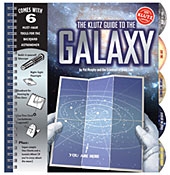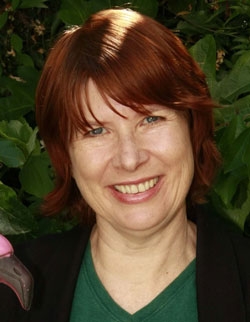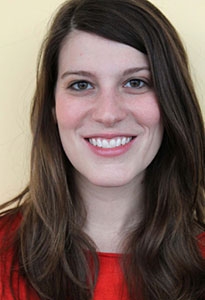Authors Pat Murphy and Anna Rothschild honored
College Park, Md., July 31, 2012 — Helping children explore the galaxy from their own back yards and the quest to measure a second with atomic precision are the stories honored with two of this year’s American Institute of Physics (AIP) Science Communication Awards.
Pat Murphy will receive the prize in the writing for children category for her book The Klutz Guide to the Galaxy. Anna Rothschild will receive the award in the new media category for her NOVA Web feature “The Amazing Atomic Clock.”
The selection committees praised both pieces for their scientific accuracy, skillful and engaging writing, and overall visual presentation.
Also in the new media category, Cameron Walker will receive a certificate of honorable mention for her multimedia essay “Auditing Astronomy Class,” published on The Last Word On Nothing blog.
“These outstanding pieces give a wonderfully human perspective to fundamental science,” said Catherine O’Riordan, AIP vice president for Physics Resources. “Both Murphy and Rothschild elegantly capture our natural world in a truly engaging and entertaining manner. AIP is very pleased to recognize their work.”
The winner in each category will receive a $3,000 honorarium, an inscribed Windsor chair, and a certificate of recognition.
Murphy will receive her award at the American Association of Physics Teachers (AAPT) Annual Meeting on Wednesday, Aug. 1, 2012, in Philadelphia, Pa. Rothschild will receive her award at the AVS International Symposium and Exhibition on Wednesday, Oct. 31, 2012, in Tampa, Fla.
Writing for Children Category

The Klutz Guide to the Galaxy is both an educational book and a collection of hands-on experiments that enable children and the young at heart to explore space. It includes ready-to-assemble tools of science, including a telescope to see the Moon’s top attractions, a red-light flashlight designed to keep readers’ night vision intact, simple star charts, and a tourist map of the Moon. Written with the characteristically irreverent Klutz attitude, this book also helps readers tell time with an included sundial and find their latitude anywhere on Earth with a built-in mariner’s quadrant.

Murphy can pinpoint the moment she became interested in astronomy. In March of 1970, her local newspaper carried a spectacular photo of Comet Bennett with a caption saying it could be observed in the pre-dawn sky. A middle-school student at the time, she woke before dawn, stepped outside the house, and stood in the front yard until the sun rose, marveling at the amazing comet with a tail that seemed to stretch halfway across the sky.
For more than 20 years, Murphy was a senior writer at the Exploratorium, San Francisco’s museum of science, art, and human perception. Today, she writes and manages the creation of science books and products for Klutz, publisher of children’s how-to books designed for doing, not just reading. Her other Klutz books include Invasion of the Bristlebots (which comes with two toothbrush robots) and The Handbook (which comes with a skeletal model of a human hand).
Murphy has also won awards for her science fiction and fantasy writing, including the Nebula Award, the Philip K. Dick Award, the World Fantasy Award, and the Christopher Award. Her works of fiction include The City Not Long After, Bones, Adventures in Time and Space with Max Merriwell, and The Wild Girls.
New Media Category
In the animated NOVA video short “The Amazing Atomic Clock,” produced to support NOVA’s four-part series “The Fabric of the Cosmos” with Brian Greene, Anna Rothschild communicates not only the physics of precision time-keeping, but also the real-world value of atomic clocks and how they keep our world running smoothly. The video addresses what seems like a straightforward question: “How do you measure a second?” The answer is given in an interview with Dr. Steve Jefferts of the National Institute of Standards and Technology in Boulder, Colo. Jefferts is an expert on how we measure time and the co-developer of one of the world's most accurate atomic clocks. In the video, Jefferts explains that these precision time pieces are necessary to keep our wireless and Web communications, electrical grid, and GPS systems running smoothly. Atomic clocks are also essential tools for fundamental scientific research.

Anna Rothschild is a production assistant for NOVA. She makes videos for the show’s website, telling engaging science stories to a web-savvy audience. After graduating with a degree in biology from Brown University in Providence, R.I., she worked as a research assistant at the American Museum of Natural History in New York City. While there, she cloned dolphin genes into bacteria, tracked down fraud in the caviar trade, and searched for malaria parasites in lizard blood.
Rothschild found her way to science journalism after realizing she could never settle on just one scientific pursuit. In 2010, she received a master’s degree in science journalism from New York University. Her work has appeared on discovermagazine.com, NPR’s Science Friday, and the Discovery Channel.
The winning entry is here: http://www.pbs.org/wgbh/nova/physics/amazing-atomic-clock.html

Honorable Mention
Receiving an honorable mention in the New Media category, Cameron Walker writes about her mother’s discovery of the excitement of science while auditing an astronomy class at the University of California at Berkeley. Walker is a writer based in California. She is a graduate of UC Berkeley and attended the graduate science writing program at UC Santa Cruz. She writes about science and a few other things for publications such as High Country News, Sky & Telescope, and Sunset. She is now a regular contributor to The Last Word On Nothing blog.
CORRECTION: Walker's post has been republished: http://www.lastwordonnothing.com/2014/09/08/guest-post-auditing-astronomy-class/
About the AIP Science Communication Awards
The AIP Science Communication Awards aim to promote effective science communication in print and new media in order to improve the general public’s appreciation of physics, astronomy, and allied science fields. The awards are presented at venues that best highlight the science covered in the publications.
For more information, contact Charles Blue ([email protected]) or visit the AIP website (https://www.aip.org/aip/awards/science-communication).
About AIP
The American Institute of Physics (AIP) is an organization of 10 physical science societies, representing more than 135,000 scientists, engineers, and educators. As one of the world's largest publishers of scientific information in physics, AIP employs innovative publishing technologies and offers publishing services for its Member Societies. AIP's suite of publications includes 15 journals, three of which are published in partnership with other organizations; magazines, including its flagship publication Physics Today; and the AIP Conference Proceedings series. Through its Physics Resources Center, AIP also delivers valuable services and expertise in education and student programs, science communications, government relations, career services for science and engineering professionals, statistical research, industrial outreach, and the history of physics and other sciences.
Contact:
Charles E. Blue
American Institute of Physics
+1 301-209-3091 (office)
+1 202-236-6324 (cell)
[email protected]
